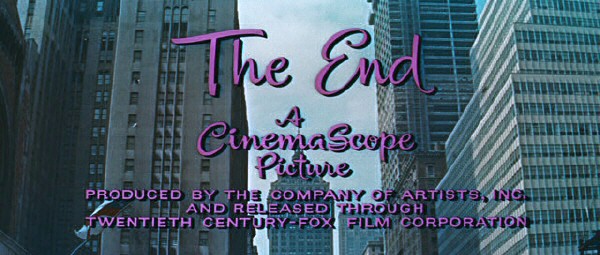
The Best of Everything
Encyclopedia Entry • Films Main
The Best of Everything
1959


Critics' Reviews • Our Reviews • Movie Posters • Lobby Cards • Books • Misc.
Click here to see photos from the film.
|
US theatrical
release: 10/9/59.
VHS release: 11/1/95. Blu-ray release: 7/14/15. Cast: Hope Lange, Stephen Boyd, Suzy Parker, Martha Hyer, Diane Baker, Brian Aherne, Robert Evans, Brett Halsey, Donald Harron, Sue Carson, Linda Hutchings, Lionel Kane, Ted Otis, June Blair, Myrna Hansen, Alena Murray, Rachel Stephens, Julie Payne. Louis Jordan as David Savage. Joan Crawford as Amanda Farrow. Credits: From the novel by Rona Jaffe. Screenplay: Edith Sommer and Mann Rubin. Producer: Jerry Wald. Director: Jean Negulesco. Camera: William C. Mellor. Art Direction: Lyle R. Wheeler, Jack Martin Smith, Mark-Lee Kirk. Music: Alfred Newman. Costumes: Adele Palmer. Editor: Robert Simpson. Title song sung by Johnny Mathis.
Plot Summary: A star-studded cast enlivens this glossy '50s soap opera, based on a novel by Rona Jaffe. The action unfolds at the Gotham-based Fabian Publishing, where numerous women work as typists under the aegis of power-wielding, shark-like editor Amanda Farrow (Joan Crawford). Farrow has achieved wealth and success, but is far from idolized by her underlings, who understand clearly that their boss has chalked up all of her accomplishments at the expense of a satisfying personal life. Caroline Bender (Hope Lange) is a recent graduate of a prestigious women's college whose sole desire in life is to marry her college sweetheart Eddie (Brett Halsey); she admits openly that she cares little for power, ambition or career advancement. She gets a job in the secretarial pool of Fabian Publishing and soon takes an apartment with some female co-workers. Caroline quickly realizes that she has a catbird seat to witness the romantic entanglements and office politics of Fabian's many female employees. Farrow is having an affair with a mysterious married man, and Caroline's roommates have tales of their own to tell: April (Diane Baker) has become pregnant by the unscrupulous Dexter (Robert Evans), who suggests she have an abortion; and Gregg (Suzy Parker) has become involved with smooth-talking Broadway director David Wilder Savage (Louis Jourdan), not the most faithful man in the world. Robert Evans's career as an actor came to an end after this film, and he later enjoyed success as a studio head at Paramount Pictures in the 1970s, supervising The Godfather, and serving as producer of such films as Chinatown and Marathon Man. ~ Mark Deming, All Movie Guide
Awards: Academy Award nominations for Best Costume Design (color)--Adele Palmer; and Best Music (original song)--Alfred Newman, music, and Sammy Cahn, lyrics (sung by Johnny Mathis).
Notes: New York City shooting locations include: Alfred E. Smith Housing Project, Central Park, Seagram Building, Sheridan Square.
Vanity Fair article (2004) on the making of the film |
Bosley Crowther in the New York Times October 9, 1959 Everything considered, "The Best of Everything" should have been better. Infinitely better, in fact, than Rona Jaffe's bestseller about Manhattan career girls. Whatever the book lacked in skill and substance, it could hardly have missed as a lively, colorful screen yarn. Yet it has. As produced by Jerry Wald, with a cast headed by Hope Lange. Stephen Boyd. Suzy Parker, Diane Baker and Joan Crawford, this handsome but curiously unstimulating drama was unveiled by Twentieth Century-Fox last night at the Paramount. (The Normandie continues the simultaneous run starting today.) Even with a sea of predominantly young faces, some splendid color shots of New York City and an office bulging with frustrations, the picture plays like a composite of many predecessors about the hearth vs. the desk. Should these diversified women — Caroline, Gregg, April, Amanda—chuck Fabian Publications for the right man? And how! This we are assured during the opening credits, as Johnny Mathis voice croons that "Love Is the Best of Everything." Could be, but Miss Jaffe's original office obstacle course was considerably sprightlier. Edith Sommer and Mann Rubin deserve some credit for compressing the vignettes, and the casting is dandy. Miss Lange is Caroline, the spunky new secretary who shelves an editor, Mr. Boyd, plus an old sweetheart, on her upward climb. Miss Parker plays the rakish Gregg, who slithers into an affair with a stage director, Louis Jourdan. As the naive April, Miss Baker drops into the arms of a slick playboy, Robert Evans. And the picture retains the most amusing and probably most likable Fabian inmate, the gabby little Bronx fiancée neatly played by Sue Carson. Two story changes warrant comment. The tender romance of the nice young widow and the aging executive, the novel's most deeply felt interlude, is barely scraped. In these roles, Donald Harron and Martha Hyer briefly collide in the Fabian corridors and gape soulfully. On the other hand, the small part of Amanda Farrow, the sleek executive witch who torments her young charges, has been fattened and overstated, even with some suave trouping by Miss Crawford. Now it must be acknowledged that director Jean Negulesco keeps the women ambulating through the corridors, various smart bars and a few ornate bedrooms with a certain pictorial agility—at least during the first half. An office picnic, an employe's wedding party (why the executives?) and a spanking metropolitan skyline are welcome antidotes to all the bruised or bleeding hearts. However, for all its knowing air and chic appointments, the picture talkily lumbers onto the plane of soap opera, under Mr. Negulesco's reverential guidance. The harsh scene in which Miss Baker is whisked away by Mr. Evans toward an illegal operation is more pretentious than realistic. Likewise poor Miss Parker's climactic crack-up, when Mr. Negulesco tilts his camera to foaming music and has the beguiling redhead (a fine imp, earlier) skulking about like a zombie. As a lecherous, pinching executive, Brian Aherne is a caricature throughout. Simply because she has the most to do, and does it gracefully, Miss Lange comes off best. It's ladies' day at the Paramount and Normandie, men. Whatever Fabian Publications is supposed to typify, it's providential the girls weren't peddling advice to the lovelorn.
Paul V. Beckley in the New York Herald Tribune (1959): You need only watch what happens when the camera turns on Joan Crawford in her role of a mean, nervous, frustrated career woman to see what the picture lacks in general. I know this kind of thing, the woman fighting an uphill battle for love, has been a Crawford specialty in recent years, but experience alone won't explain the electricity. Let's admit first off that the script gives her no more than a fingerhold on the story, that it asks her to navigate in two emotional directions at once, and to make a sudden unaccountable change of character in the denouement, but just the same, when she comes on, you wake up and begin to wonder what's going to happen. You feel badly cheated when it turns out finally that they're not going to let you even take a look at her particular married man and that "rabbit-faced" wife of his. All her problems are worked out off-stage, but even so, restricted to a few mean looks and some vitriolic dialogue, Miss Crawford comes near making the rest of the picture look like a distraction.
MonsterHunter website: If this movie isn't going to get by on the strength of the over-the-hill stardom of its headlining has-been, then how does it fill two hours? Who are these other goofs that populate this woman-eating office, where people spend a lot of time talking about all the work they have to do, but don't actually spend any time doing it?...All of these dumbed down office crises could be excused because of the time period in which this movie was made if there was anything to root for in the protagonists or if they actually accomplished something worthwhile because of their trials. Instead, you have a woman finding Prince Charming in her doctor (woman's fantasy #16), a woman dumping the man who loves her for one more shot at her ex, but then dumping him and finding the new boyfriend still receptive to dating her traitorous ass (woman's fantasy #7), and finally you have the crazy ex-girlfriend falling off her ex's fire escape to her death (men's fantasy #3)...
digsmagazine
review
(2003) |
If you've seen The Best of Everything and would like to share your review here, please e-mail me. Include a photo of yourself or avatar to accompany your review, a star-rating (with 5 stars the best), and any of your favorite lines from the film.
Rating:
I dislike this prettily-shot film in the same way that I dislike the pretty 1998-2004 TV show Sex and the City (which many of today's online bloggers insist that BOE was a forerunner of). Both make claims of showing "independent women in the Big City," but both also offer utterly shallow takes on women and their situations/thoughts: which apparently center solely on finding a mate (although Sex/City also includes "getting a good deal on expensive shoes" as another ongoing primary concern).
The Best of Everything (BOE) follows recent Radcliffe grad "Caroline" (Hope Lange), who's just gotten her first job in New York City. She shows up on her first day at Fabian Publishing in white gloves and hat, clutching the ad (in the "Help Wanted - Female" section of the paper) that reads: "SECRETARIES: You Deserve the Best of Everything!" She soon encounters fellow co-workers from different walks of life, as well as a bitchy boss (Joan as "Amanda Farrow"), who---gasp!---often makes her stay late.
Caroline also discovers males in the office. Stephen Boyd's good-looking "Mike" is a drunkard who soon falls in love with her. He looks at her longingly and doesn't take advantage of her when's she's drunk (gee, thanks!), but then he's later given to shouted lectures (at a company picnic, no less) like: "Men aren't lovers, they're competition! So if you can't join 'em, let's lick 'em!" Later in the film, after Caroline has been promoted from secretary to editor, Mike makes snarky comments about her having Amanda Farrow's job, her office, and----in another month or two---her life. And this is supposed to be the nicest guy in the film?!
The majority of the film marches on like this, as a warped morality tale. First of all: What ever happened to the spunky "Girl in the Big City" films of the 20s and 30s (like, say, Joan's Our Dancing Daughters or Dancing Lady) where young women are struggling to make it, and their efforts are taken seriously? Where, sure, sometimes awful things happen, and sometimes a girl does wind up going back home to be married to the boy next door, but... there's usually a girl left who ends up making her own way in the city. As sometimes happens in real life... In this film, though, we don't really care what happens to the main character "Caroline" because she's so bland, and everyone around her is so stupid and/or obnoxious!
Joan's role here, a small one as editor "Amanda Farrow," is almost primarily a one-note "bitchy boss" in conflict with Lange's "Caroline"---and Amanda's "career-woman" life also serves as a repeated warning given by Mike (and other characters) to Caroline---although Amanda does have a few seconds of reprieve from this caricature. Amanda is initially only a mean boss giving Caroline extra work to do after-hours, but in later scenes, some humanity is added: First, we see her on the phone with a married lover, who has yet again cancelled their weekly date. Amanda starts out in understanding mode, but, in a now-classic Joan line, winds up slamming down the phone with "Now you and your rabbit-faced wife can both go to hell!" Another sympathetic scene is when Amanda has hired secretary/aspiring actress Gregg (Suzy Parker) to serve at her dinner party; director David Savage (Louis Jourdan) shows up late, and Gregg answers the door while Amanda is still in the kitchen. Amanda looks forward to seeing him, but by the time she comes out of the kitchen, he's already run off with Gregg (the two nastily mocking Amanda while they escape).
My favorite of Joan's scenes comes near the very end of the movie, with her publishing cohort Mr. Shalimar (Brian Aherne, her co-star in 1935's I Live My Life), after she's returned to her old job: Amanda: Are you still pinching all the girls? Shalimar: Of course... You don't imagine I'm interested in their minds, do you? [He lights her cig and invites her to dinner, which she accepts.] Amanda: Promise, no pinching? Shalimar: I promise nothing.
The only bit of panache in the entire picture! While watching, I thought this should have been the final line.
Upon first watching BOE in the early 2000s, I was mightily irritated by both its overt sexist message and its overt dour view of life. And I am still irritated upon re-watching today. Not as a matter of political correctness, but just because I know, via life itself, that things are not CONSTANTLY so utterly grim! This movie has almost no sense of play or sense of humor. Every man is a cad, every woman is a sucker and/or victim. The only brief moments of levity are supplied by the butt-pinching editor Mr. Shalimar---not that butt-pinching should be encouraged in the workplace, but that I'd rather have my butt pinched by the sassy Mr. Shalimar (who'd once worked with Eugene O'Neill) than being lectured by the generic "good guy" main love interest in the film (Mike) re how awful my life is going to be if I insist on having a career! (Shalimar has some spark and, in the workplace, is seen conversing with both Caroline and Amanda about literary matters; Mike, on the other hand, is a dreary, lecturing dolt.)
In this sad-sack of a film, though, the heroines exist solely to be abused: The innocent April (Diane Baker) wants love, but falls for a cad who pressures her into sex and then drives her to an abortion clinic when she naively thinks they're headed for a wedding chapel. The much-more-worldly actress Gregg (the great-looking Suzy Parker), who's been around the block a few times, ends up as a lunatic going through her director-lover's trash-cans and pleading for his love. Lange's Caroline is in love with a former boyfriend who's just married the daughter of his company owner. The fates of these main characters are ALL either mediocre or downright sorry: April, who loses her child, gets a doctor who doesn't judge her too much but who brings his socks over for darning; Gregg... well [SPOILER ALERT], beauty or not, she just winds up dead; Caroline's ex-boyfriend wants her for a mistress---so there's THAT or her other choice: the perpetually sodden, lecturing MIke...
(Oddly and psychotically, while denigrating alternatives to marriage, the film also constantly mocks the simple working-class "Mary Agnes," who's concerned primarily with getting married, and who does get married, and who judges others for fooling around outside of marriage. Which is it, film-makers? You're not telling me, extremely misogynistically, that EVERY SINGLE THING that women might do is wrong, are you?)
On a positive note: The film's outdoor cinematography is gorgeous: The sweeping aerial shots of the New York City skyline are beautiful, as are the street shots, giving the viewer a real sense of the city in 1959. The outside scenes are a real treat to look at. (And the indoor office scenes were shot within the historic Seagram Building: "Mondrian"-inspired, say the commenters of the extras.) My extra half-star is for this scenery (and for Joan Crawford's and Brian Aherne's entertaining interludes)---not for this overall depressing film.
The DVD commentary is dominated, and hindered, by some of "film historian" Sylvia Stoddard's ignorant comments. (BOE novel author Rona Jaffe is co-commenter, but Stoddard talks about 75% of the time.) Blatant errors: Stoddard says that Joan married husband Al Steele in 1952 (they married in 1955). And she characterizes Joan's "Mildred Pierce" titular character as being "despicable," and then makes up a quote from Joan re "Mildred": "I'd prefer playing a despicable character in a fabulous film..." (Mildred was not by any means a "despicable character." And Joan never made any such "despicable vs. fabulous" comment.) Stoddard does give a bit of insight (if she is to be believed) into the famous "deleted scene" from BOE, in which Joan's Amanda Farrow is waiting alone in a bar for her married lover, who stands her up. According to Stoddard, the young bartender offers to take her home; Amanda replies: "Nobody takes Amanda Farrow home." Ha! I can actually hear/see Joan delivering that! (Or did Stoddard just get this from "No one puts Baby in a corner"?)
Rating:
I gather that Joan Crawford was a relatively late addition to the cast of The Best of Everything.
Jerry Wald---who produced Joan’s biggest hits from her Warner Bros.
heyday---thought she would be perfect for the part of Amanda Farrow.
Joan’s husband, Al Steele, had just died, so Joan accepted, reportedly
for financial but perhaps also for emotional reasons.
Whatever the backstory, thank goodness for Joan! I found it hard to get invested in any of the lead characters. The women throw themselves at a bunch of cads, falling over themselves for men who reject them. The men are jerks, using women, discarding them when things gets inconvenient. The only two characters I found interesting were
Joan and Joan’s old co-star Brian Aherne (1935's I Live My Life)
as Mr. Shalimar. Shalimar is the office lecher and butt pincher, which
was cheeky (pun intended) back in the day, but cringey today. Joan is
Amanda Farrow, an editor, who is a counterpoint to a trio of sweet young
things. In some respects, she serves as a warning---if you don’t latch
on to a man, any man, even a bad man, you may get a career, but you risk
being a bitter old crone like Joan/Amanda, whose only shot at romance
is dating a married man on the sly.
Amidst all the sweetness, Amanda Farrow is a dash of Tabasco. Equal parts acid and heat. Amanda is Crystal Allen (Joan’s character in The Women, 1939) twenty years on. Joan has only a few scenes, but when she does appear, like Crystal, she injects excitement into the movie. Unfortunately, there is no Roz Russell or Norma Shearer in BOE for her to spar with. Amanda has the best line in the film, which she shouts as she slams down the phone on her married lover---whom we never see: “You and your rabbit-faced wife can both go to hell!" IMDB reports that Joan scripted this scene herself. (If so: Bravo, Joanie!) Amanda does undergo a transformation in the end to a kinder, gentler version of herself after failing to rekindle an old love affair in Ohio. Artifice. But I can live with it. BOE is directed by Jean Negulesco, who directed Humoresque (1946), considered by many to be one of Joan’s finest acting performances. But BOE is too long and too plodding, although I admit that I have cinematic ADD. BOE is similar in many ways to 1925’s Sally, Irene and Mary, updated and moved from NYC's Theater District to Park Avenue. However, Sally is 58 minutes, while BOE drones on for 2 hours! I think BOE would have been improved with a reduction in content and time. For instance, my only interest in Gregg (Suzy Parker) was in the first minutes, wondering if she was the actress who played Ginger on Gilligan's Island (alas, it is not). [Editor's Note: Tina Louise played "Ginger."] The Gregg character or April Morrison (Diane Baker) could have easily been left on the cutting room floor. Add in missing Joan content that IMDB says was cut out, compress to 75 min or so, and you have a more watchable movie. For future viewings, I'm going to fast forward to Joan's scenes. Interestingly, while period PR focused on the young ingenues in the cast, the DVD and other more recent materials and reviews seem to focus on Joan, The Enduring Star. As they should, since Joan is the most watchable thing in this movie. 2 stars; without Joan it’d struggle to make 0.5 stars.
Keith Seigle (February 2011)
I believe that Joan Crawford was extremely depressed after the sudden death of her self-proclaimed "soul mate," husband Alfred Steele. After Steele's death, she asked a favor of her dear old friend and producer of the film, Jerry Wald, and he agreed to give her a small supporting role with top billing, which, after almost 35 years of being the star and actress, was well deserved.
Her appearance with Brian Aherne was not their first together; these two remnants of the old studio system seem well cast and provide a look into the old Hollywood way of being, while concentrating on a new wave of young starlets-in-waiting. This film doesn’t stand out; Crawford later said that many scenes with herself and Aherne were edited out to give more exposure to the younger players.
Here, Crawford took Diane Baker under her wing, much like she did with Ann Blyth (Veda in “Mildred Pierce”), later starring with Baker in “Strait-Jacket." Crawford later became typecast post-“What Ever Happened to Baby Jane?", starring in Queen-of-Scream, low-budget “horror” campy films such as “I Saw What You Did," "Berserk," and her final appearance in the horrendously bad film “Trog.” No, the film isn't an exclusive Crawford vehicle, but after Alfred Steele died,
she just wanted some work and called an old friend.
Rating:
Though Joanie, Joan, Joan took the cover and billing for this movie, it was Hope Lange's gig after all. What pleased me the most was that no chicken salad slipped its way into this movie, unless it was served at the company picnic, which the viewers were not privy to. In any event, what shocked me in this 1959 movie was how much Joanie, Joan, Joan had aged from 1955's Queen Bee. I believe Al Steele must have just passed on when she made this movie 'cause, Child, she was all " toe up." Actually, she looked better almost a decade later in Berserk than she did in TBOE.
Anyway, getting back to the highlights of Joanie, Joan, Joan.
When she threw her cocktail party and had her secretary, Greg, be her flunky for the event, a wayward director shows up late and while Joanie, Joan, Joan's making him a sandwich, Greg runs off with him. (Mind you, Greg is a woman here.) For sure I thought, in all Joanie, Joan, Joan tradition, that Greg's head would roll the next day, but Joanie, Joan, Joan took it with a grain of salt. Now it was shocking in and of itself that she didn't impale Greg on a metal gate, but Greg got hers later!
As the embattled warhorse of Fabian Publishers, Joanie, Joan, Joan is carrying on with a married man herself, as you do. The hoot line in the movie is when she is arguing with him on the phone, becomes frustrated, and tells him, "I know you're married - - and I wouldn't ask for no more, but I won't settle for no less - - what! - - well, you and that rabbit-faced wife of yours can both GO TO HELL!" Hey folks, for a lady to use salty talk like that in 1959 did raise eyebrows, and for the very meek and mild also caused a few banana mouths, might I add.
Joanie, Joan, Joan was clearly at the end of the line here, with little hopes of an extension or a line spur added, but her name value was the drawing force here and I give the three-star credit to Hope Lange for always maintaining dignity with class through her own trials and tribulations. (Did anyone else notice how every dreadful telephone call to be received was answered by Hope Lange - - oy vey, how she kept her cool!) Well worth watching, although Joanie, Joan, Joan's appearance here was equal to that of a repeated cameo.
Rating:
I have read retrospective reviews from critics and Miss Crawford herself. I completely agree with their summation. This movie I can watch and really go about my business; it might possibly go well with the flu.
It is true that you need only watch when Miss Crawford appears. She is bold, classy and lovely in a mature way. She looks like a boss, she acts like a boss, but yet she is all women, feminine and masculine at the same time, even displaying a little grace and sex appeal. I wish the script changed and they called it “The Amanda Farrow Story” -- now that would be an interesting and engaging movie!
I cannot mention anyone else because nothing else mattered in the movie! One thing that was interesting to me was in the original script: Miss Crawford and Mr. Brian Aherne had no scenes together and he felt some fans would expect them to appear together since they starred together in the 1935 comedyI Live My Life. I appreciate his nostalgia; he was allowed to write their scene and it comes off nicely.
The only other feelings I had for the movie were watching Miss Crawford and delighting when she appeared on the screen. I kept thinking and wondering why she did not get better roles toward the end of her career? She is actually still ripe in this movie and her acting is matched perfectly with her character and her small role. She did make the best of all her scenes and that is why I wanted more of Amanda and a producer in Hollywood who could help Miss Crawford get better roles. For this viewer the pang of sadness is there because I know where she ends up. With Trog!
Todd (June 2005) Rating:
You think you know what you're in for when The Best of Everything begins. Johnny Mathis is crooning the swoonsome theme song while an impossibly well-scrubbed New York City skyline dominates the widescreen; the credits appear to be written with "Barely Pink" Revlon lipstick; fresh-faced Hope Lange makes a perky entrance in a smartly tailored suit and hat, which you almost expect her to throw into the air, beating Mary Richards to the punch. Why, you say to yourself, this will be a fluffy, frothy indulgence.
Wrong.
The film's tone is remarkably dark and ugly for its time period; it pulls no punches in its depiction of women in the workplace (and society in general) as second class citizens who are mere sexual playthings for the appetites of their (higher-paid) male colleagues and bosses. Despite the glorious DeLuxe color, scrumptious photography, and scads of luxurious costumes (where do these secretaries store, much less pay for, all their gorgeous gowns?), The Best of Everything is depressingly downbeat. Even with adultery, pre-marital sex, workplace romances, alcholic lechers and two-timing society playboys thrown into the mix--all the ingredients are there for a fizzy cocktail of a Peyton Place-style melodrama--the result is almost unbearably un-entertaining.
It is a pleasure, then, when Joan Crawford appears on the screen as Amanda Farrow, the bane of every secretary's existance. Playing a hardened, embittered career woman--quite a change for Crawford, who, despite an increasing steeliness to her characterizations, clung to her romantic leading lady status well into her fifties--Crawford injects some much-needed camp and bitchiness into the leaden proceedings.
Unfortunately, Crawford's screen time is negligible; the main story revolves around three of 20th Century Fox's newer starlets, Hope Lange, Diane Baker and the fabulous supermodel of the time, Suzy Parker. That Crawford's few scenes effectively blow everyone else's off the screen certainly goes without saying; one wishes the nighttime serial format had blossomed a bit earlier--it would have been much more interesting to see The Best of Everything unfold in that manner, and to delve deeper into the Amanda Farrow character.
With the arrival of The Best of Everything on DVD, my suggestion is this: use the scene selection skip directly to any involving Crawford. All the rest, you may file under "Trash--NO!!!"
|
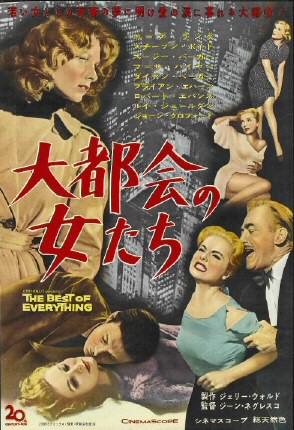
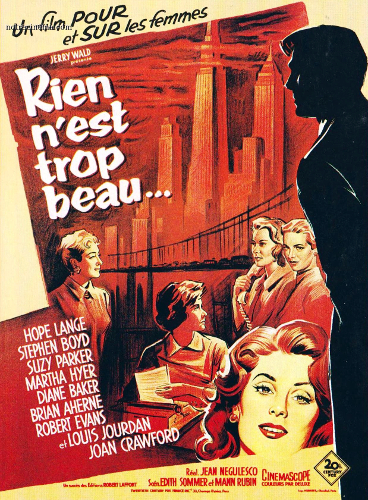
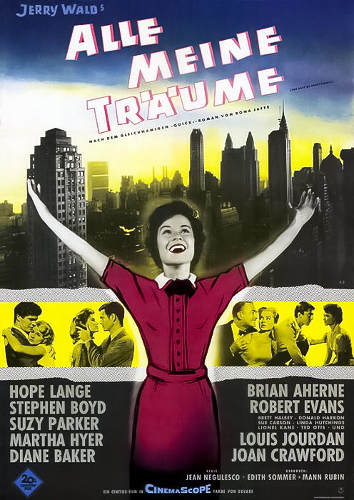
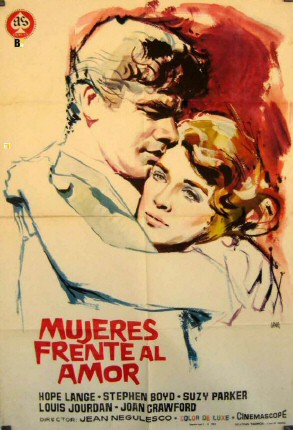
Above: Japan, France, Germany, Spain
Below: US


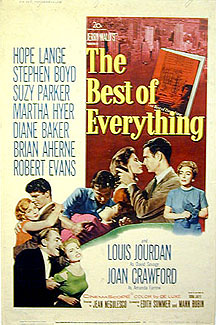
Below: UK, Yugoslavia, Australia
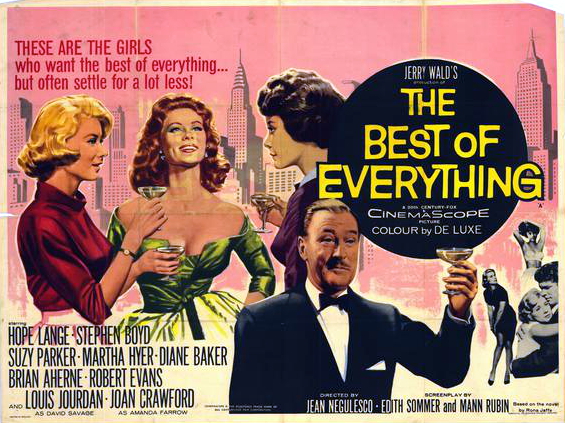
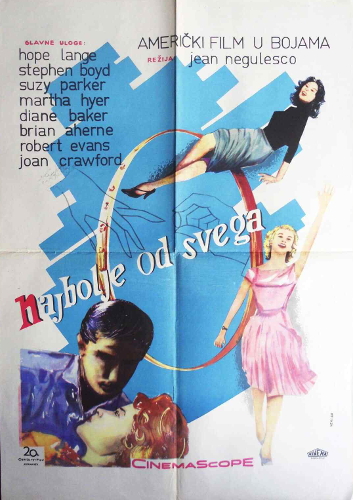
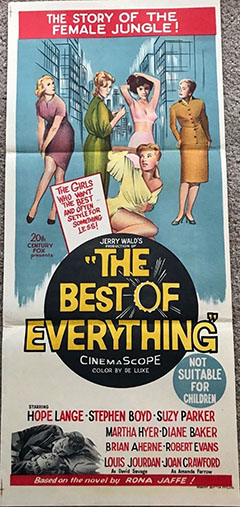
Below: Belgium, Sweden
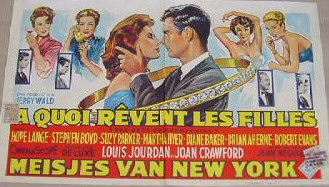
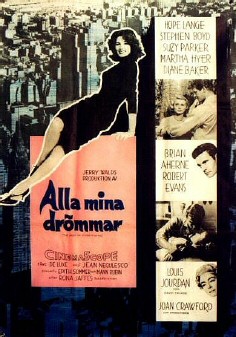

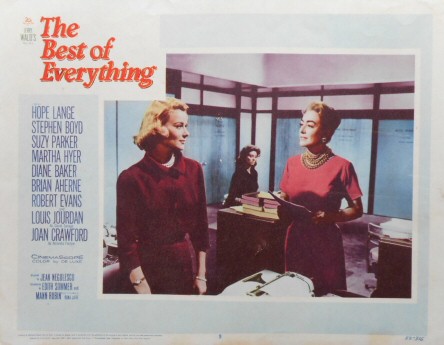
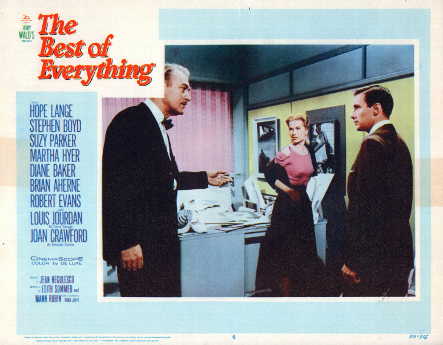
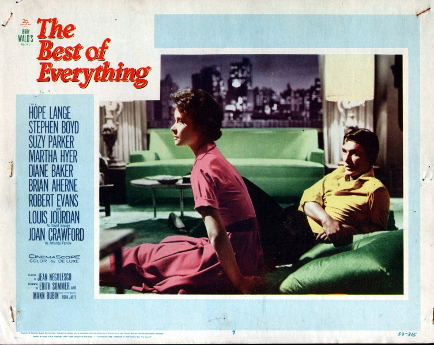
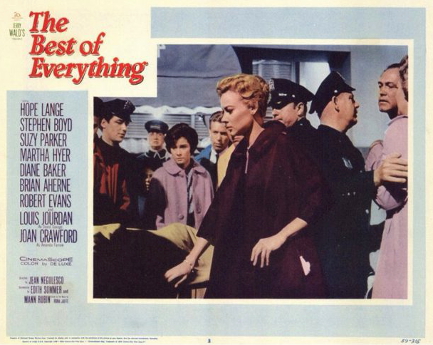
Above: US lobby cards. Below: A Mexican lobby card.

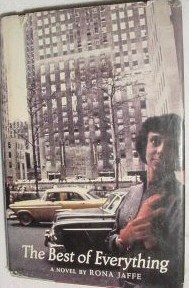

See this site's Books Related to Joan Movies page for more info.

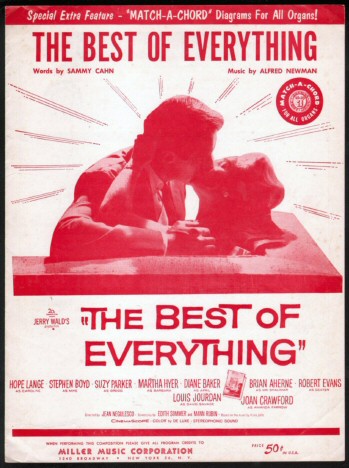
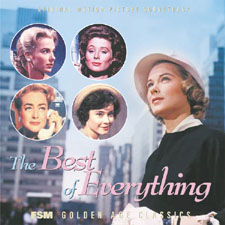
Above left and center: Johnny Mathis Columbia single cover and U.S. sheet music. Above right: Best of Everything 2001 soundtrack CD cover.
See this site's Audio:Recordings page for more info on all.

Above: US trade ad.


Above: Promo ad (left) and publicity mailout for media outlets.
Below: 1967 US newspaper ad for a TV showing.

The Best of Everything
